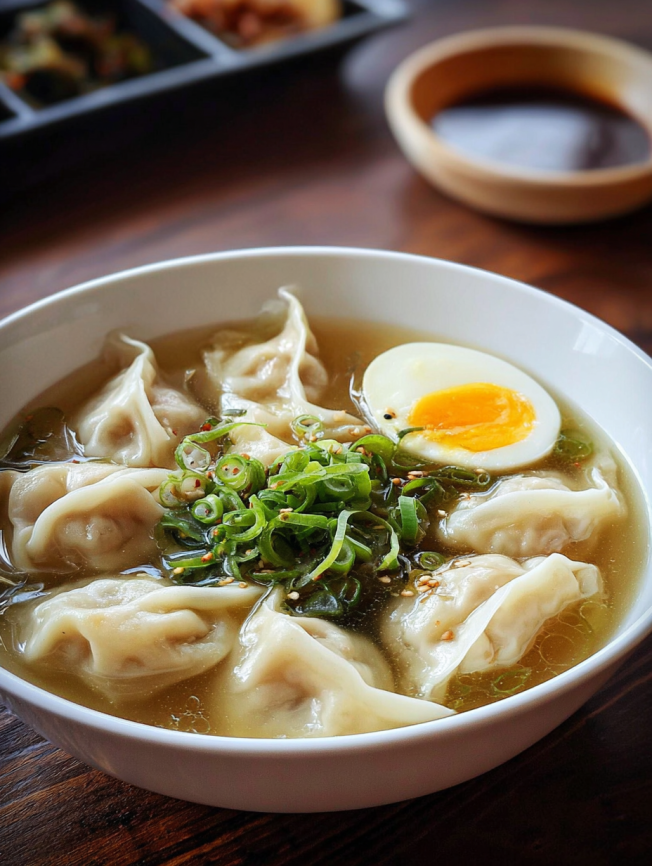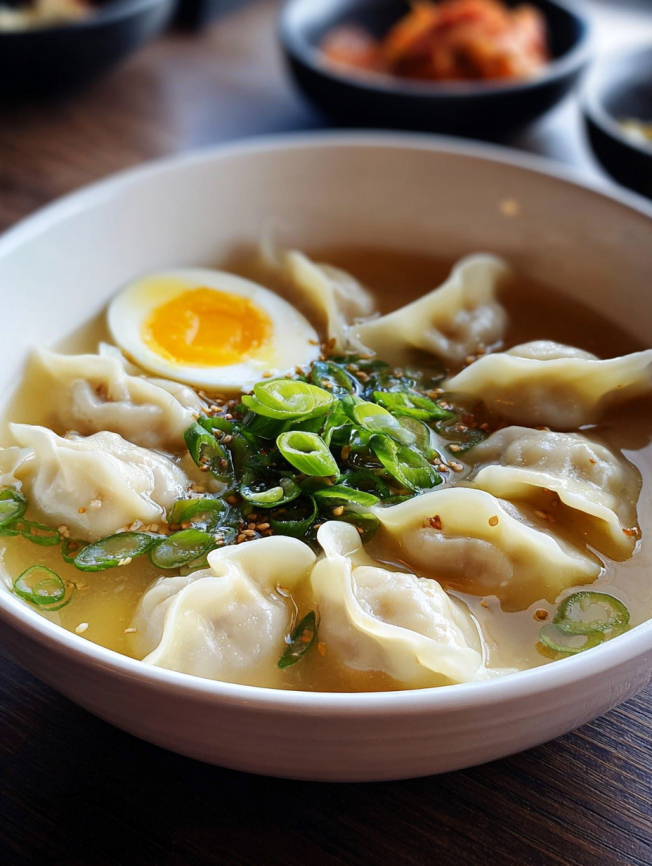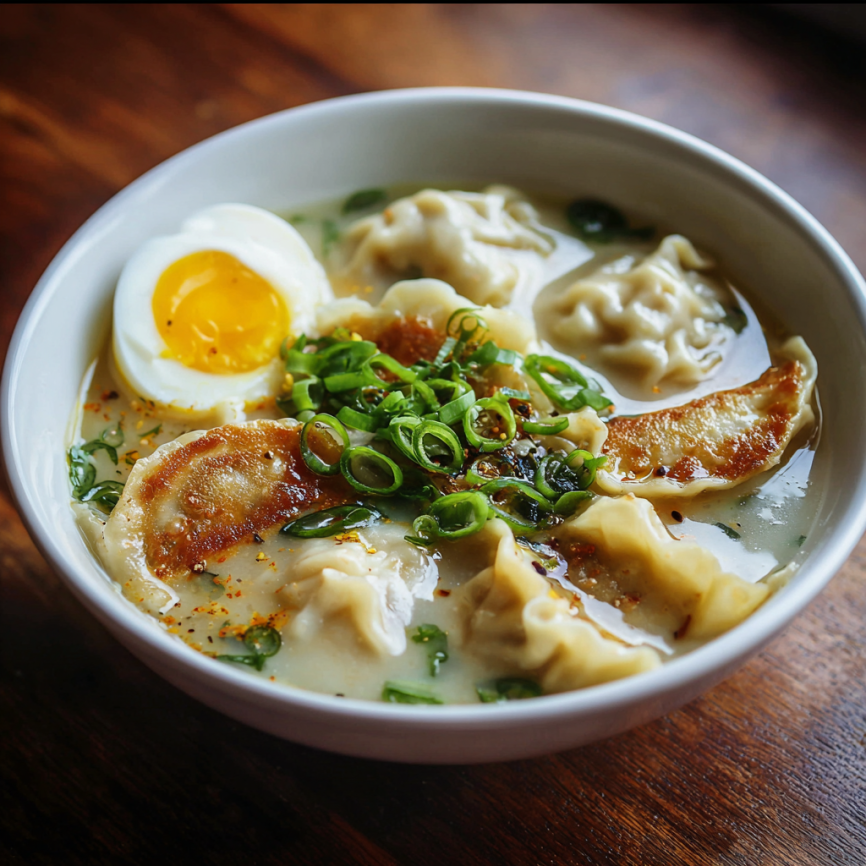Growing up in a Korean-American household, New Year’s morning always began with the same ritual: my grandmother would rise before dawn to prepare enormous pots of Manduguk, filling our home with the most incredible aromas. As children, we’d gather around her kitchen counter, mesmerized by her swift hands folding delicate dumplings while she shared stories about her own childhood in Seoul. Now, decades later, I find myself recreating this same magical soup for my own family, understanding that Manduguk represents far more than just a meal—it’s a bridge connecting generations through tradition, love, and the simple act of sharing warm food together.
Why This Manduguk Recipe Will Transform Your Winter Cooking
Manduguk stands out among comfort foods because it masterfully balances simplicity with profound satisfaction. Unlike heavy Western soups that can leave you feeling sluggish, this Korean dumpling soup provides nourishment without weighing you down, making it perfect for any time of day.
The recipe’s versatility makes it incredibly appealing for busy home cooks. Whether you’re using store-bought dumplings for a quick weeknight dinner or taking time to craft homemade mandu for special occasions, Manduguk adapts beautifully to your schedule and skill level.
Moreover, this soup offers exceptional nutritional balance. The protein-rich dumplings provide sustained energy, while the rice cakes contribute satisfying chewiness and carbohydrates. Meanwhile, the egg ribbons add delicate texture and additional protein, creating a complete meal in a single bowl.
Additionally, Manduguk serves as an excellent introduction to Korean cuisine for newcomers. Its familiar dumpling-soup format feels approachable, while the distinctive flavors of sesame oil and Korean rice cakes gently introduce more adventurous taste profiles.
Essential Ingredients for Authentic Manduguk
Main Components
- 12 Korean dumplings (mandu) – Available frozen at Asian markets or homemade for superior flavor
- 6 cups beef or anchovy broth – Forms the savory foundation; choose based on your flavor preference
- 1 cup sliced Korean rice cakes (tteok) – Provides signature chewy texture and cultural authenticity
- 2 eggs, beaten – Creates delicate ribbons that add visual appeal and protein
Flavor Enhancers
- 1 scallion, finely chopped – Adds fresh, mild onion flavor and vibrant color
- 1 garlic clove, minced – Contributes essential Korean flavor depth
- 1 teaspoon sesame oil – Provides nutty aroma and authentic finishing touch
- Salt and pepper to taste – For seasoning balance
Optional Garnishes
- Roasted seaweed strips (gim) – Adds oceanic flavor and traditional presentation
Step-by-Step Cooking Instructions
Broth Preparation
Start by bringing your chosen broth to a rolling boil in a large pot over medium-high heat. The quality of your broth significantly impacts the final dish, so choose carefully between beef broth for richness or anchovy broth for traditional Korean flavor.
While the broth heats, prepare your mise en place by chopping scallions, mincing garlic, and beating the eggs until smooth. This preparation ensures smooth cooking once you begin adding ingredients.
Building the Soup
Add the sliced rice cakes to the boiling broth first, as they require the longest cooking time. Simmer for 5-7 minutes until they become tender but maintain their characteristic chew. Overcooked rice cakes become mushy, so monitor them carefully.
Next, gently add the dumplings to the pot. Fresh dumplings will float when fully cooked, typically taking 5-6 minutes. Frozen dumplings may require an additional minute or two, so adjust timing accordingly.
Final Touches
Stir in the minced garlic during the last few minutes of cooking, allowing its flavor to infuse without becoming harsh. Season the broth with salt and pepper, tasting as you go to achieve perfect balance.
Create the signature egg ribbons by slowly drizzling beaten eggs into the hot soup while stirring gently with chopsticks or a fork. The key is maintaining movement to prevent the eggs from clumping together.

Beautiful Serving Suggestions
Present Manduguk in individual bowls warmed beforehand to maintain optimal temperature. Garnish each serving with freshly chopped scallions and optional seaweed strips for authentic presentation.
Serve alongside traditional Korean banchan (side dishes) such as kimchi, pickled radish, or seasoned spinach for a complete Korean meal experience. The tangy, fermented flavors complement the soup’s mild richness perfectly.
For special occasions, consider adding a drizzle of chili oil or a sprinkle of toasted sesame seeds to individual bowls, allowing diners to customize their experience according to personal preference.
Delicious Recipe Variations
Seafood Manduguk
Replace beef broth with kombu (kelp) and dried shrimp stock for an oceanic flavor profile. Add small shrimp or pieces of fish cake during the last few minutes of cooking for additional protein and authentic Korean taste.
Vegetarian Version
Use vegetable or mushroom broth as the base and ensure your dumplings contain only vegetable fillings. Shiitake mushrooms add umami depth that compensates for the absence of meat-based broth.
Spicy Manduguk
Add a tablespoon of gochugaru (Korean red pepper flakes) or a teaspoon of gochujang (Korean chili paste) for those who enjoy heat. Start with less and adjust according to your spice tolerance.
Hearty Winter Version
Include additional vegetables such as sliced carrots, napa cabbage, or mushrooms for extra nutrition and texture. Add these vegetables after the rice cakes but before the dumplings.
Smart Make-Ahead Strategies
Prepare components separately for efficient assembly during busy weekdays. Cook rice cakes until almost tender, then store them in the refrigerator for up to three days. When ready to serve, simply reheat them in the broth.
Broth can be prepared up to three days in advance and actually improves in flavor during storage. Keep it refrigerated and bring to a boil before adding other ingredients.
However, avoid storing the completed soup with egg ribbons, as they become tough and unappetizing when reheated. Instead, add fresh beaten eggs each time you reheat the soup for optimal texture and appearance.
For homemade dumplings, prepare them completely and freeze on parchment-lined baking sheets. Once frozen solid, transfer to freezer bags for storage up to three months.
Expert Tips and Cultural Notes
Dumpling Selection: Korean grocery stores offer various mandu types, from pork and vegetable to kimchi-filled varieties. Each brings unique flavors, so experiment to find your family’s preference.
Rice Cake Preparation: Soak dried rice cakes in warm water for 10 minutes before cooking if they seem particularly hard. This prevents them from taking too long to soften in the soup.
Egg Ribbon Technique: The secret to perfect egg ribbons lies in temperature control and movement. Ensure your soup is actively simmering (not violently boiling) when adding eggs, and maintain gentle stirring motion.
Cultural Timing: Traditionally eaten on New Year’s morning, Manduguk symbolizes growing a year older and starting fresh. Many Korean families prepare it together, making the cooking process as meaningful as the eating.
Broth Enhancement: For deeper flavor, toast garlic slices in sesame oil before adding to the soup. This technique, common in Korean cooking, adds complexity without additional ingredients.

Frequently Asked Questions
Can I use wonton wrappers instead of Korean dumplings? While wonton dumplings can substitute in a pinch, Korean mandu have different seasonings and textures that significantly impact the dish’s authenticity. Korean dumplings typically contain glass noodles and specific vegetable combinations that create the traditional flavor profile.
Why do my rice cakes become mushy? Overcooking is the most common cause of mushy rice cakes. They should maintain a pleasant chew similar to al dente pasta. Fresh rice cakes cook faster than frozen ones, so adjust timing accordingly and test for doneness frequently.
How do I prevent the egg from scrambling instead of forming ribbons? Temperature control is crucial—the soup should be gently simmering, not rapidly boiling. Pour the beaten eggs very slowly while stirring continuously in one direction. If your soup is too hot, remove it from heat for 30 seconds before adding eggs.
Can I make this soup spicy? Absolutely! Add gochugaru (Korean red pepper flakes) or a small amount of gochujang (Korean chili paste) to taste. Start conservatively, as you can always add more heat but cannot remove it once added.
What’s the difference between Manduguk and Tteokguk? Tteokguk contains only rice cakes in broth and is the traditional New Year’s soup, while Manduguk includes dumplings alongside the rice cakes. Both dishes hold cultural significance, but Manduguk offers more protein and varied textures.
How long can I store leftover Manduguk? Store leftover soup without egg ribbons for up to three days in the refrigerator. The dumplings and rice cakes will absorb some broth, so you may need to add additional liquid when reheating. Always add fresh egg ribbons when serving reheated soup.

